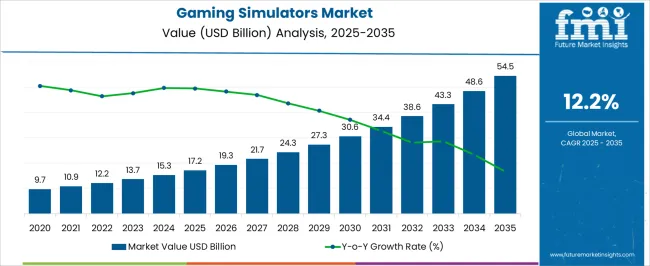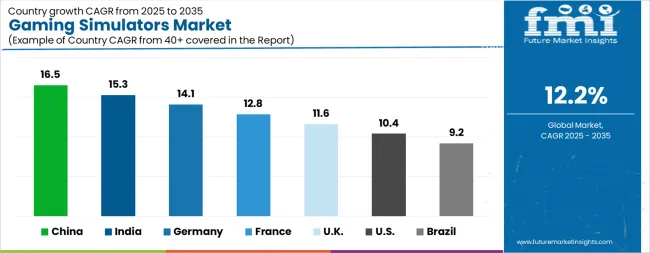The Gaming Simulators Market is estimated to be valued at USD 17.2 billion in 2025 and is projected to reach USD 54.5 billion by 2035, registering a compound annual growth rate (CAGR) of 12.2% over the forecast period.

| Metric | Value |
|---|---|
| Gaming Simulators Market Estimated Value in (2025 E) | USD 17.2 billion |
| Gaming Simulators Market Forecast Value in (2035 F) | USD 54.5 billion |
| Forecast CAGR (2025 to 2035) | 12.2% |
The Gaming Simulators market is experiencing robust growth as technological advancements and increasing consumer demand for immersive experiences continue to reshape the entertainment landscape. The market is being driven by the rising popularity of realistic simulation in both home and commercial settings, fueled by enhanced graphics processing, motion tracking, and haptic feedback technologies.
Increasing interest in e-sports, virtual reality experiences, and interactive learning platforms is expanding the adoption of gaming simulators across diverse end-user segments. Additionally, the market is being supported by the proliferation of high-speed internet, affordable computing hardware, and gaming platforms that enable multi-user interaction.
As hardware and software integration becomes more sophisticated, the ability to deliver highly personalized, engaging, and safe simulation experiences is being strengthened, creating new growth opportunities The future outlook of the market is shaped by continuous innovation in immersive technologies, increasing consumer spending on entertainment, and rising demand for realistic simulation training across sectors such as education, professional sports, and recreational gaming.
The gaming simulators market is segmented by component, end user, and geographic regions. By component, gaming simulators market is divided into Hardware and Software. In terms of end user, gaming simulators market is classified into Home, Supermarkets and malls, Play stations, and Others. Regionally, the gaming simulators industry is classified into North America, Latin America, Western Europe, Eastern Europe, Balkan & Baltic Countries, Russia & Belarus, Central Asia, East Asia, South Asia & Pacific, and the Middle East & Africa.

The Hardware component is projected to hold 51.60% of the Gaming Simulators market revenue share in 2025, making it the leading component segment. This prominence is being driven by the critical role of hardware in delivering high-quality immersive experiences, where performance, responsiveness, and reliability are essential.
Growth is being supported by increasing consumer expectations for advanced graphics, motion control, and tactile feedback, which require sophisticated hardware systems including controllers, joysticks, steering wheels, and motion platforms. Additionally, hardware solutions are being adopted in commercial settings for professional training, competitive gaming, and entertainment centers, where robust and customizable systems provide scalable deployment.
The demand is also being fueled by the compatibility of hardware platforms with emerging software updates, allowing users to upgrade experiences without replacing entire systems As technology continues to advance and simulation environments become more realistic, the hardware segment is anticipated to retain a leading position due to its indispensable role in enabling immersive, high-fidelity gaming simulator experiences.

The Home end-user segment is expected to account for 44.80% of the Gaming Simulators market revenue share in 2025, making it the largest end-use segment. This leadership is being driven by the growing interest among consumers in immersive gaming experiences that replicate professional-grade simulation in a residential setting. Increased affordability of gaming hardware, including consoles, VR headsets, and motion-enabled peripherals, has facilitated widespread adoption.
Consumers are increasingly seeking realistic and interactive environments for entertainment, skill development, and recreational activities, which has further reinforced the growth of home-based simulators. The expansion of online gaming communities and digital distribution platforms has enabled seamless access to simulation content, making home installations more attractive and cost-effective.
Furthermore, the flexibility to integrate new software features and updates with existing hardware allows prolonged usability and value for money With continued interest in personalized gaming experiences and interactive entertainment, the home segment is expected to sustain its market leadership while driving innovation in simulator design and functionality.
Gaming Simulators allow players to enjoy adventurous elements excitingly and with enjoyment, because these situations are impossible to recreate physically. In the current stressful life, people are attracted to such a way of recreating energy. Thus, the Gaming Simulators market finds a rising opportunity during the forecast period.
The Gaming Simulators market is projected to grow worldwide in the coming years due to day by day innovation and increasing creativity in the Gaming Simulators techniques. Moreover, with the young generation, the elder people are also attracted towards Gaming Simulators for reducing stress and refresh the life; which is a major factor responsible for the rise of the Gaming Simulators market.
Gaming Simulators are the components which are used in different type of games for providing the exact simulators of playing the game in real life. Various components which are used for Gaming Simulators are panels, wheels, boxing gloves, guns, panels, paddles, and others. In the coming years the Gaming Simulators market is expected to have a potential growth due to increase in adoption of the virtual stress reliving techniques by people.

| Country | CAGR |
|---|---|
| China | 16.5% |
| India | 15.3% |
| Germany | 14.1% |
| France | 12.8% |
| U.K. | 11.6% |
| U.S. | 10.4% |
| Brazil | 9.2% |
The Gaming Simulators Market is expected to register a CAGR of 12.2% during the forecast period, exhibiting varied country level momentum. China leads with the highest CAGR of 16.5%, followed by India at 15.3%. Developed markets such as Germany, France, and the U.K. continue to expand steadily, while the U.S. is likely to grow at consistent rates. Brazil posts the lowest CAGR at 9.2%, yet still underscores a broadly positive trajectory for the global Gaming Simulators Market. In 2024, Germany held a dominant revenue in the Western Europe market and is expected to grow with a CAGR of 14.1%. The U.S. Gaming Simulators Market is estimated to be valued at USD 6.5 billion in 2025 and is anticipated to reach a valuation of USD 17.4 billion by 2035. Sales are projected to rise at a CAGR of 10.4% over the forecast period between 2025 and 2035. While Japan and South Korea markets are estimated to be valued at USD 783.6 million and USD 443.8 million respectively in 2025.

| Item | Value |
|---|---|
| Quantitative Units | USD 17.2 Billion |
| Component | Hardware and Software |
| End User | Home, Supermarkets and malls, Play stations, and Others |
| Regions Covered | North America, Europe, Asia-Pacific, Latin America, Middle East & Africa |
| Country Covered | United States, Canada, Germany, France, United Kingdom, China, Japan, India, Brazil, South Africa |
| Key Companies Profiled | CAE, Atec Simulation, Antilate, Kratos Simulation Solutions, Thales Group, FlightSafety International, EON Reality, Vrgineers, Cruden, L3 Technologies, SimXperience, and Boeing |
The global gaming simulators market is estimated to be valued at USD 17.2 billion in 2025.
The market size for the gaming simulators market is projected to reach USD 54.5 billion by 2035.
The gaming simulators market is expected to grow at a 12.2% CAGR between 2025 and 2035.
The key product types in gaming simulators market are hardware and software.
In terms of end user, home segment to command 44.8% share in the gaming simulators market in 2025.






Our Research Products

The "Full Research Suite" delivers actionable market intel, deep dives on markets or technologies, so clients act faster, cut risk, and unlock growth.

The Leaderboard benchmarks and ranks top vendors, classifying them as Established Leaders, Leading Challengers, or Disruptors & Challengers.

Locates where complements amplify value and substitutes erode it, forecasting net impact by horizon

We deliver granular, decision-grade intel: market sizing, 5-year forecasts, pricing, adoption, usage, revenue, and operational KPIs—plus competitor tracking, regulation, and value chains—across 60 countries broadly.

Spot the shifts before they hit your P&L. We track inflection points, adoption curves, pricing moves, and ecosystem plays to show where demand is heading, why it is changing, and what to do next across high-growth markets and disruptive tech

Real-time reads of user behavior. We track shifting priorities, perceptions of today’s and next-gen services, and provider experience, then pace how fast tech moves from trial to adoption, blending buyer, consumer, and channel inputs with social signals (#WhySwitch, #UX).

Partner with our analyst team to build a custom report designed around your business priorities. From analysing market trends to assessing competitors or crafting bespoke datasets, we tailor insights to your needs.
Supplier Intelligence
Discovery & Profiling
Capacity & Footprint
Performance & Risk
Compliance & Governance
Commercial Readiness
Who Supplies Whom
Scorecards & Shortlists
Playbooks & Docs
Category Intelligence
Definition & Scope
Demand & Use Cases
Cost Drivers
Market Structure
Supply Chain Map
Trade & Policy
Operating Norms
Deliverables
Buyer Intelligence
Account Basics
Spend & Scope
Procurement Model
Vendor Requirements
Terms & Policies
Entry Strategy
Pain Points & Triggers
Outputs
Pricing Analysis
Benchmarks
Trends
Should-Cost
Indexation
Landed Cost
Commercial Terms
Deliverables
Brand Analysis
Positioning & Value Prop
Share & Presence
Customer Evidence
Go-to-Market
Digital & Reputation
Compliance & Trust
KPIs & Gaps
Outputs
Full Research Suite comprises of:
Market outlook & trends analysis
Interviews & case studies
Strategic recommendations
Vendor profiles & capabilities analysis
5-year forecasts
8 regions and 60+ country-level data splits
Market segment data splits
12 months of continuous data updates
DELIVERED AS:
PDF EXCEL ONLINE
Gaming Laptop Market Size and Share Forecast Outlook 2025 to 2035
Gaming Console Market Size and Share Forecast Outlook 2025 to 2035
Gaming Gadgets Market Size and Share Forecast Outlook 2025 to 2035
Gaming Monitors Market Analysis - Size, Share & Forecast 2025 to 2035
Gaming Hardware Market Analysis by Gaming Platform, Product Type, End-user, and Region Through 2035
Web3 Gaming Market Report - Growth & Forecast 2025 to 2035
Radar Simulators Market Size and Share Forecast Outlook 2025 to 2035
Wearable Gaming Technology Market Size and Share Forecast Outlook 2025 to 2035
Demand and Trend Analysis of Gaming Monitor in Western Europe Size and Share Forecast Outlook 2025 to 2035
Demand and Trend Analysis of Gaming Monitor in Japan Size and Share Forecast Outlook 2025 to 2035
Demand and Trend Analysis of Gaming Monitor in Korea Size and Share Forecast Outlook 2025 to 2035

Thank you!
You will receive an email from our Business Development Manager. Please be sure to check your SPAM/JUNK folder too.
Chat With
MaRIA